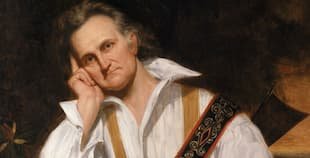On Auks and Audubon
Born This Day Series, Social Media Content
Consider the auk;
Becoming extinct because he forgot how to fly,
And could only walk.
Consider man,
Who may well become extinct
Because he forgot how to walk
And learned how to fly before he thinked.
Ogden Nash
Tufted Auks (detail)
When we see a guy shooting birds out of the air, we say “That jerk’s needlessly killing wildlife to compensate for a lack of, er, something else.”
Two hundred years ago, people probably didn’t think that way, but they did note that James Audubon’s hobby was shooting birds—hundreds at a time. He’d then select attractive corpses, wire them into life-like poses and paint pictures of them. People called him a ‘romantic figure’, not imagining that he would become history’s greatest wildlife painter.
John James Audubon is now known as a great American ornithologist, naturalist and painter. But he wasn’t actually American—he was French. And his name was really Jean Rabin—his father was a bit of a lad and, to avoid embarrassment (his), his numerous children took their respective mothers’ names.
He was born in 1785, in what is now Haiti, the illegitimate son of a French naval officer. In 1803, to dodge Napoleon’s draft, he obtained a fake passport and headed to the US. He arrived in New York with yellow fever and, so that he could recover, the ship’s captain placed him in a home of a Quaker family. Where he had little to do but look at birds and draw. Et voilà, he discovered his métier.
Off he went to paint birds, walking 50,000 North American miles. Along the way, he identified 35 new species and sub-species and revolutionized the way his world saw and portrayed nature. He respected birds as predators and gave them personality and character. While others had shown birds in life-like poses, or in their environmental context, or in their true sizes, he was the first to combine all elements. Although he was entirely self-taught, his work is highly-stylized and textured and exhibits the realism, scientific accuracy and artistic merit of a technically-disciplined painter.
Fast forward, through a lot of twists and turns (including bankruptcy, having to shoot birds to feed his children and losing 200 drawings to voracious rats), he completed 435 paintings. He headed to Scotland in search of cash and production capabilities. In Edinburgh, then London, his work was engraved, hand-painted and printed. It took 12 years but, in 1844, the 29” x 39” Birds of America was published.
Ever the hopeless entrepreneur, Audubon only sold 200 copies. But his work created a huge market for wildlife art and, while he dressed up in buckskin to lecture at such august institutions as the University of Edinburgh (where Charles Darwin was in the audience), other people pirated his work and profited handsomely.
Eskimo Curlew
Audubon left us a record of the New World as it was before humans got hold of it. In his time, there were 5 billion passenger pigeons; he recorded a flock so large that it took three days to pass. The last one died in the Cincinnati Zoo, in 1914. He reported a two-month period in which a Halifax man sold 400,000 auk eggs (at .25/doz.). The last auk died in Iceland in 1844; now, there are more Audubon auk prints than there are auk museum specimens.
Humans hunted four Audubon subjects to extinction—there was once the Eskimo Curlew and the Labrador Duck. Some of his other subjects are now endangered, including the Whooping Crane, Peregrine Falcon, Harlequin Duck and Northern Bobwhite.
The Birds of America remains the finest ornithological work ever produced, and one of the greatest illustrated books of all time. About 120 copies are known to exist; if you can find one for sale, it’ll run you about $10 million. (There is a copy in the Toronto Reference Library; it includes the result of Audubon’s Canadian travels, the 100-plate Birds of Canada collection.) Not only is the book a stunning artistic and scientific achievement, but it forever changed the way we see, know and love birds. Merci Jean.


